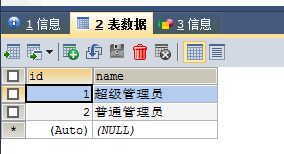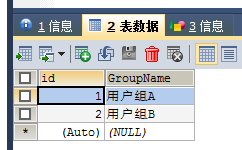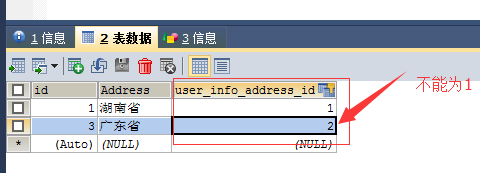I. Database Operation
1. Create model tables
Basic structure:
1 #coding:Utf8 2 from django.db import models 3 4 class userinfo(models.Model): 5 #Without models.AutoField,By default, a id Auto-addition 6 name = models.CharField(max_length=30) 7 email = models.EmailField() 8 memo = models.TextField()
Field Explanation:

1. models.AutoField Self-adding = int(11)
2. If not, a column named id will be generated by default. If a custom self-adding column is to be displayed, the column must be set to primary_key=True.
3.2, models.CharField
4. Must max_length parameter
53. models.BooleanField Boolean type = tinyint(1)
6. Can't be empty, Blank=True
7. models. ComaSeparated IntegerField
8. Inherit CharField, so the max_length parameter must be used
9.5, models.DateField date type date
10. For parameters, auto_now =True updates this time each time; auto_now_add is only the first creation of the add, and the subsequent updates do not change.
Model. DateTime Field Date type datetime
12. Parameters with DateField
Decimal decimal type = decimal
14. Integer bits max_digits and decimal_places must be specified
158, models.EmailField string type (regular expression mailbox) = varchar
16. Regular expressions for Strings
17 9, models.FloatField Floating point type = double
1810, models.IntegerField
19 11, models.BigIntegerField
20 integer_field_ranges ={
21 'SmallIntegerField':(-32768,32767),
22 'IntegerField':(-2147483648,2147483647),
23 'BigIntegerField':(-9223372036854775808,9223372036854775807),
24 'PositiveSmallIntegerField':(0,32767),
25 'PositiveIntegerField':(0,2147483647),
26 }
Model. IPAddressField string type (ip4 regular expression)
2813, models.GenericIPAddressField string types (ip4 and ip6 are optional)
The parameters protocol can be: both, ipv4, ipv6
30. When validating, errors will be reported based on settings
3114, models.NullBooleanField
32 15, models. Positive Integer Fiel
33 16, models. PositiveSmallInteger Field
34 17, models.SlugField minus sign, underscore, letter, number
3518, models.SmallIntegerField
36. The fields in the database are tinyint, smallint, int, bigint.
3719, models.TextField string = longtext
3820, models.TimeField Time HH: MM [: SS [. uuuuuuu]]
39 21, models.URLField string, address regular expression
Model. BinaryField
41 23, models. Image Field pictures
4224, models.FilePathField file
Parametric interpretation:

1 1,null=True 2. Can fields in the database be null? 3 2,blank=True 4. Can null values be allowed when data is added to django's Admin 5 3,primary_key =False 6. Primary key, after setting primary key to AutoField, will replace the original self-adding id column. 7 4, auto_now and auto_now_add 8. auto_now Auto Creation - Whether added or modified, it is the time of the current operation 9. auto_now_add Auto Creation - Always at Creation Time 10 5,choices 11 GENDER_CHOICE =( 12 (u'M', u'Male'), 13 (u'F', u'Female'), 14 ) 15 gender = models.CharField(max_length=2,choices = GENDER_CHOICE) 16 6,max_length 17, default 18. Display name of field in verbose_name Admin 19, name|db_column 20 10, unique=True 21 11, db_index =True 22 12, editable=True. Is it editable in Admin 23 13, error_messages=None 2414, auto_created=False 25 15, help_text: Help information in Admin 26 16,validators=[] 27 17,upload-to
Data manipulation
Check:
Add:
Delete:
Amend:
common method 1 # Get Number 2 # 3 # models.Tb1.objects.filter(name='seven').count() 4 # Greater than, less than 5 # 6 # models.Tb1.objects.filter(id__gt=1) # Get a value with id greater than 1 7 # models.Tb1.objects.filter(id__lt=10) # Get a value with id less than 10 8 # models.Tb1.objects.filter(id__lt=10, id__gt=1) # Get values with id greater than 1 and less than 10 9 # in 10 # 11 # models.Tb1.objects.filter(id__in=[11, 22, 33]) # Get data with id equal to 11, 22, 33 12 # models.Tb1.objects.exclude(id__in=[11, 22, 33]) # not in 13 # contains 14 # 15 # models.Tb1.objects.filter(name__contains="ven") 16 # models.Tb1.objects.filter(name__icontains="ven") # icontains case insensitive 17 # models.Tb1.objects.exclude(name__icontains="ven") 18 # range 19 # 20 # models.Tb1.objects.filter(id__range=[1, 2]) # Range bettwen and 21 # Other similar 22 # 23 # startswith,istartswith, endswith, iendswith, 24 # order by 25 # 26 # models.Tb1.objects.filter(name='seven').order_by('id') # asc 27 # models.Tb1.objects.filter(name='seven').order_by('-id') # desc 28 # limit ,offset 29 # 30 # models.Tb1.objects.all()[10:20] 31 # group by 32 from django.db.models import Count, Min, Max, Sum 33 # models.Tb1.objects.filter(c1=1).values('id').annotate(c=Count('num')) 34 # SELECT "app01_tb1"."id", COUNT("app01_tb1"."num") AS "c" FROM "app01_tb1" WHERE "app01_tb1"."c1" = 1 GROUP BY "app01_tb1"."id"
1 # Get Number 2 # 3 # models.Tb1.objects.filter(name='seven').count() 4 # Greater than, less than 5 # 6 # models.Tb1.objects.filter(id__gt=1) # Get a value with id greater than 1 7 # models.Tb1.objects.filter(id__lt=10) # Get a value with id less than 10 8 # models.Tb1.objects.filter(id__lt=10, id__gt=1) # Get values with id greater than 1 and less than 10 9 # in 10 # 11 # models.Tb1.objects.filter(id__in=[11, 22, 33]) # Get data with id equal to 11, 22, 33 12 # models.Tb1.objects.exclude(id__in=[11, 22, 33]) # not in 13 # contains 14 # 15 # models.Tb1.objects.filter(name__contains="ven") 16 # models.Tb1.objects.filter(name__icontains="ven") # icontains case insensitive 17 # models.Tb1.objects.exclude(name__icontains="ven") 18 # range 19 # 20 # models.Tb1.objects.filter(id__range=[1, 2]) # Range bettwen and 21 # Other similar 22 # 23 # startswith,istartswith, endswith, iendswith, 24 # order by 25 # 26 # models.Tb1.objects.filter(name='seven').order_by('id') # asc 27 # models.Tb1.objects.filter(name='seven').order_by('-id') # desc 28 # limit ,offset 29 # 30 # models.Tb1.objects.all()[10:20] 31 # group by 32 from django.db.models import Count, Min, Max, Sum 33 # models.Tb1.objects.filter(c1=1).values('id').annotate(c=Count('num')) 34 # SELECT "app01_tb1"."id", COUNT("app01_tb1"."num") AS "c" FROM "app01_tb1" WHERE "app01_tb1"."c1" = 1 GROUP BY "app01_tb1"."id"
2. Detailed explanation of common fields
1 class UserInfo(models.Model): 2 name = models.CharField(max_length=32) 3 ctime = models.DateTimeField(auto_now=True) 4 uptime = models.DateTimeField(auto_now_add=True)
1 from app01 import models 2 def home(request): 3 models.UserInfo.objects.create(name='yangmv') 4 after = models.UserInfo.objects.all() 5 print after[0].ctime 6 return render(request, 'app01/home.html')
Modification of table structure
1 from django.db import models 2 3 # Create your models here. 4 class UserInfo(models.Model): 5 name = models.CharField(max_length=32) 6 ctime = models.DateTimeField(auto_now=True) 7 uptime = models.DateTimeField(auto_now_add=True) 8 email = models.EmailField(max_length=32,null=True) 9 email1 = models.EmailField(max_length=32,default='rose@qq.com')
After making migrations, migrate. Old data automatically applies new rules
Model. ImageField
models.GenericIPAddressField IP
ip = models.GenericIPAddressField(protocol="ipv4",null=True,blank=True)
img = models.ImageField(null=True,blank=True,upload_to="upload")
Common parameters
1 class UserInfo(models.Model): 2 USER_TYPE_LIST = ( 3 (1,'user'), 4 (2,'admin'), 5 ) 6 user_type = models.IntegerField(choices=USER_TYPE_LIST,default=1)
2. Concatenated Table Structure
- One-to-many: models. ForeignKey (other tables)
- Many-to-many: models. ManyToManyField (other tables)
- One-to-one: models. OneToOneField (other tables)
Application scenarios:
- One-to-many: When a row of data is created in a table, there is a radio drop-down box (which can be selected repeatedly).
For example, when creating user information, you need to select a user type [ordinary user] [gold user] [platinum user], etc. - Many-to-many: To create a row of data in a table, there is a drop-down box with multiple choices
For example, to create user information, you need to specify multiple hobbies for users - One-to-one: When creating a row of data in a table, there is a radio drop-down box (the contents of the drop-down box disappear once used).
For example, after a period of time, 10 columns can not meet the needs of the original table containing 10 columns of data to save relevant information, so it is necessary to add 5 columns of data to the original table.
One-to-many:
1 from django.db import models 2 3 4 # Create your models here. 5 class UserType(models.Model): 6 name = models.CharField(max_length=50) 7 class UserInfo(models.Model): 8 username = models.CharField(max_length=50) 9 password = models.CharField(max_length=50) 10 email = models.EmailField() 11 user_type = models.ForeignKey('UserType')
This is the UserInfo table, which corresponds to the ID of the UserType table through the foreign key

This is the data for the User_Type table

Many-to-many:
1 from django.db import models 2 3 4 # Create your models here. 5 class UserType(models.Model): 6 name = models.CharField(max_length=50) 7 class UserInfo(models.Model): 8 username = models.CharField(max_length=50) 9 password = models.CharField(max_length=50) 10 email = models.EmailField() 11 user_type = models.ForeignKey('UserType') 12 class UserGroup(models.Model): 13 GroupName = models.CharField(max_length=50) 14 user = models.ManyToManyField("UserInfo")
The Django model automatically creates the third relational table that corresponds to UserInfo_id and UserGroup_id.
The UserInfo table shows as follows:
UserGroup table

Django Automatically Generated Correspondence Table

userinfo_id = 1 is Boss and belongs to 1 (user group A)
One-to-one: (One-to-many additions cannot be repeated)
1 from django.db import models 2 3 4 # Create your models here. 5 class UserType(models.Model): 6 name = models.CharField(max_length=50) 7 class UserInfo(models.Model): 8 username = models.CharField(max_length=50) 9 password = models.CharField(max_length=50) 10 email = models.EmailField() 11 user_type = models.ForeignKey('UserType') 12 class UserGroup(models.Model): 13 GroupName = models.CharField(max_length=50) 14 user = models.ManyToManyField("UserInfo") 15 class Admin(models.Model): 16 Address = models.CharField() 17 user_info_address = models.OneToOneField('UserInfo')

